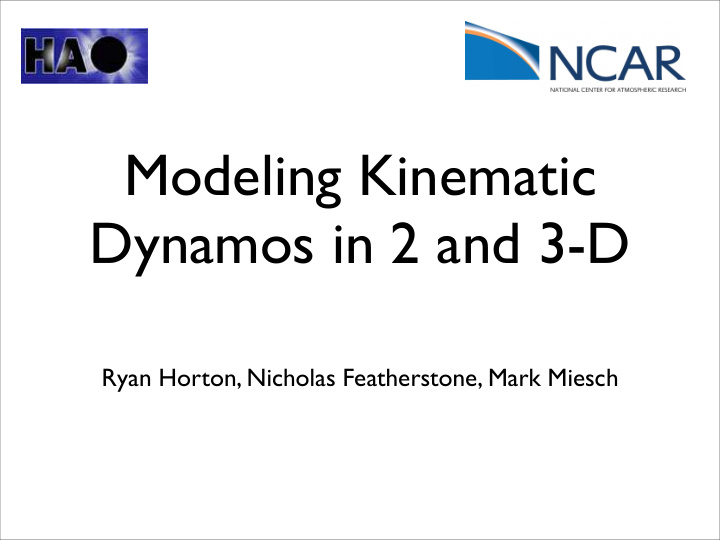



Modeling Kinematic Dynamos in 2 and 3-D Ryan Horton, Nicholas Featherstone, Mark Miesch
Motivation • Convection on many di fg erent scales • Magnetic events on many di fg erent scales • Long (~22 year) solar cycle • How do all these di fg erent scales fit together? • How can we know how accurately our models are working? 2
Granulation The Dynamic Sun Convection on Many Scales Helioseismic Inference SST Meridional Circulation Di fg erential Rotation Ω NSSL v θ Tachocline 500 nHz 360 nHz SDO/AIA Supergranulation Howe et al. 2000; Schou et al. 2002 Zhao et al. 2012
The Magnetic Sun Solar Cycle (The Big Mystery) Global-Scale Magnetism Small-Scale Magnetism (Magnetic Carpet) \ Lites et al (2008) SDO/HMI
The Induction Equation Dissipation Generation Always zero Compression and Expansion Advection (Movement) Stretching and Shear 5
Magnetic Reynolds Number Dissipation Generation • Ratio of generation to dissipation • Essentially the reciprocal of the diffusivity 6
Methods • Numerical solution to induction equation Magneato • Periodic 3-D domain • Computational domain broken up into many small cubes 1 B B2 1 A • Constrained transport (Evans & Hawley 1988) d dA 2 • Preserves divergence free magnetic field by integrating EMF around cell faces EMF 2 EMF 1 7
Objectives Examine the dynamo properties Assessing Dynamo Properties of “solar-like” convective flows of Numerical Di fg usion There is always diffusion present Some examples of flows in current solar models Featherstone et al. 2009 Evans and Hawley 1988 8
E fg ects of Vortical Flows in 2-D • Flow “winds up” the field • Takes field in one direction and generates field in another direction • Eventually dissipation always wins as fields in opposing directions come together Mo fg att 1978 9
Code Validation The Expulsion of Magnetic Fields by Eddies, Weiss 1966 10
Assessing Numerical Di fg usion Runs with Different Eta (128x128) 5e-7 Average Field Strength 5e-5 5e-6 5e-4 1000 200 400 100 40 11
Magnetic Reynolds Number vs Peak of Magnetic Field for Different Grid Spacings 128x128 ~Rm^(1/3) Peak of Average Magnetic Energy 64x64 32x32 Magnetic Reynolds Number
“2.5-D” Flow • Invariant in z-direction Into Slide • Vortices do not connect Out of Slide 13
Different Grid Spacings with 2.5-D Flow Peak Magnetic Energy ~Rm^(1/3) 256x256 ~Rm^(1/3) 128x128 Magnetic Reynolds Number 14
Creating a Dynamo • Impossible in 2-D (di fg usion always wins) • Field lines will wrap • Opposing field comes together and cancels • Possible in 3-D • “stretch, twist, fold” 15
Fully 3-D Flow A-flow B-flow Total flow is a weighted sum of the two 16
128 Cubed 3-D Flow Magnetic Energy Field Lines 17
After Many Iterations... Magnetic Energy Field Lines 18
Fully 3-D Dynamo y g r e n E c i t e n g a M Iterations (*25) 19
Overview • Characterized numerical di fg usion in two and three dimensional flows • Showed that the numerical di fg usion depended on grid size • Showed the numerical di fg usion varied with flow • Creation of a 3-D dynamo motivated by those flows present in solar models 20
Recommend
More recommend